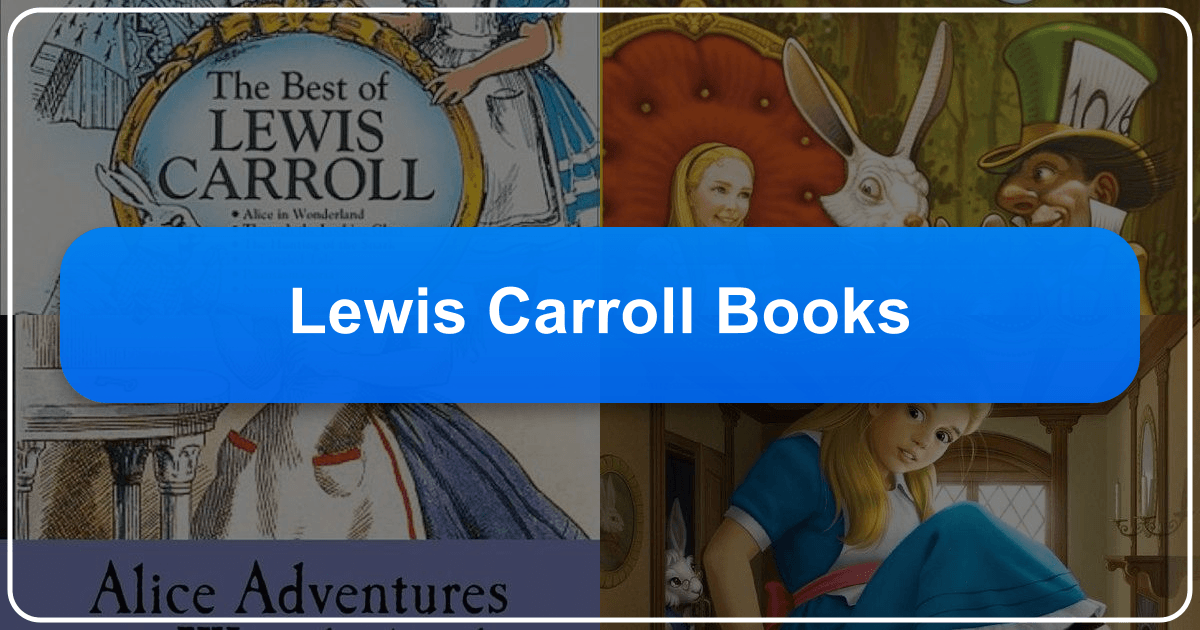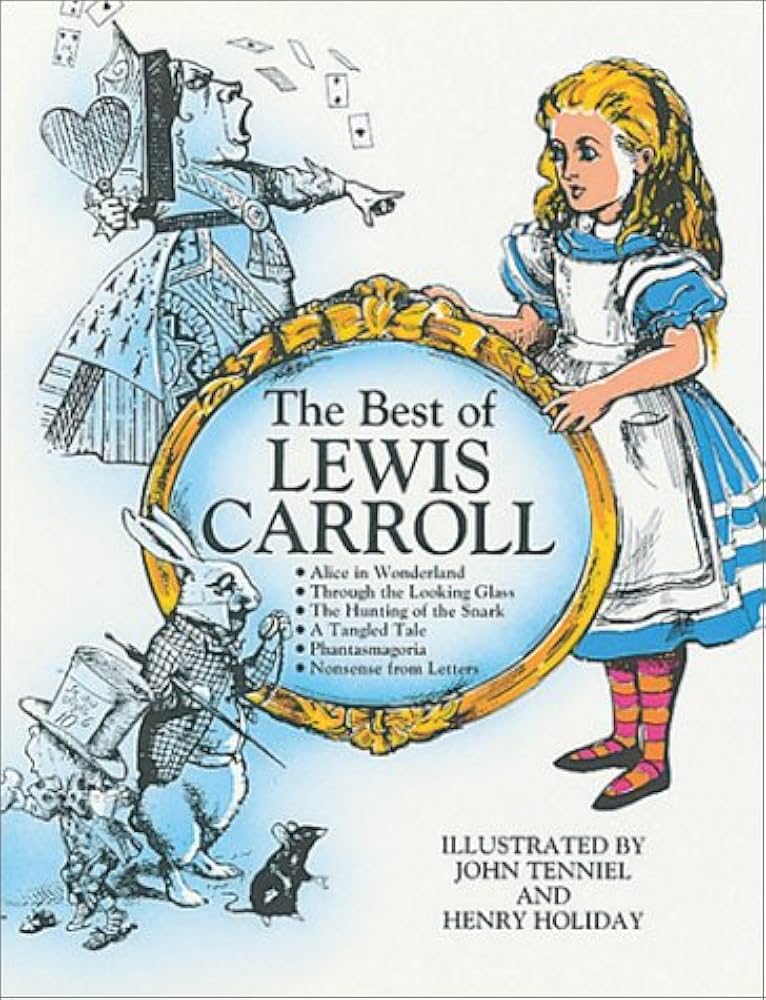Lewis Carroll Books: A Comprehensive Exploration

Lewis Carroll, the pen name of Charles Lutwidge Dodgson, remains one of the most celebrated and influential authors in English literature. His fantastical narratives, whimsical poems, and ingenious wordplay continue to captivate readers of all ages, transcending cultural boundaries and inspiring countless adaptations. This comprehensive exploration delves into the world of Lewis Carroll’s books, examining their genres, enduring legacy, and multifaceted cultural impact. We will explore his works through various lenses, analyzing their literary merit, educational value, and enduring appeal across generations.
The Enchanting Worlds of Lewis Carroll’s Books
Lewis Carroll’s literary contributions are multifaceted, spanning various genres and showcasing remarkable versatility. His most famous works, Alice’s Adventures in Wonderland and Through the Looking-Glass, are quintessential examples of children’s literature, though their sophisticated wordplay and underlying social commentary resonate deeply with adult readers as well. These novels are not simply children’s stories; they are layered narratives brimming with philosophical musings, social satire, and linguistic innovation. The fantastical landscapes, illogical events, and unforgettable characters create enduringly magical experiences for readers of all ages. Beyond the Alice books, Carroll produced a diverse body of work encompassing:

-
Fantasy Fiction: The Alice books represent the pinnacle of Victorian fantasy, creating worlds that defy logic and playfully subvert societal expectations. The narratives feature talking animals, shifting identities, and nonsensical logic, creating an atmosphere of enchanting absurdity. The Alice books remain exemplary models for authors pursuing innovative storytelling.
-
Nonsense Literature: Carroll’s mastery of language is evident in his nonsense poems and verses, such as “Jabberwocky” and “The Walrus and the Carpenter.” These works employ invented words and playful syntax, highlighting the arbitrary nature of language while simultaneously constructing coherent and evocative narratives. They exemplify the power of imagination and linguistic creativity, impacting both children’s and adult literature.
-
Mathematical Puzzles and Games: Beyond his literary achievements, Carroll was a skilled mathematician who created a vast collection of puzzles and games, demonstrating his intellectual prowess and playful approach to problem-solving. These works showcase his unique ability to combine logical reasoning with creativity, impacting the development of recreational mathematics.
-
Poetry: Carroll’s poetry is equally diverse, ranging from the nonsensical to the more sentimental. His poems, often integrated into his longer works, serve to enhance the narrative and thematic depth, utilizing rhythm and rhyme to create a musicality that complements the fantastical settings and character interactions.
Genres and Classifications
Carroll’s works defy easy categorization. While his Alice books are firmly established within children’s literature, they transcend simple genre boundaries, encompassing elements of fantasy, satire, and social commentary. His nonsense poems are unique, blending elements of poetry, wordplay, and humor. His mathematical works reside in recreational mathematics and logic, yet they often demonstrate significant literary merit. This diversity underscores the breadth of Carroll’s creative genius, making his works accessible and appealing to a broad spectrum of readers and scholars.
Classics, Bestsellers, and New Releases
The Alice books, consistently ranked among the greatest works of children’s literature, remain perennial bestsellers, with numerous editions and translations available worldwide. Their enduring popularity highlights the timeless appeal of Carroll’s imaginative world-building and creative use of language. Furthermore, new editions, adaptations, and critical analyses of Carroll’s works continue to be published regularly, demonstrating the ongoing interest in his legacy. Many modern reinterpretations and visual adaptations further demonstrate the enduring influence of his creativity on popular culture.

Book Reviews and Critical Reception
Critical reception of Lewis Carroll’s work has been overwhelmingly positive, with numerous scholars and critics highlighting the depth, originality, and enduring impact of his writing. Analyses range from explorations of his linguistic innovation to interpretations of his underlying social commentary, revealing the complex layers within his seemingly simple narratives. Reviews of individual works often focus on their playful absurdity, underlying darkness, and enduring capacity to engage readers across diverse cultural and generational backgrounds. Many acknowledge the enduring influence of Carroll’s work on both children’s and adult literature.
Lewis Carroll: The Man Behind the Masterpieces

Understanding Lewis Carroll’s life and personality is crucial to appreciating his literary works. Charles Lutwidge Dodgson, a mathematician by profession, led a seemingly reserved life, yet his writings reveal a remarkably playful and inventive mind. This duality between his professional life and his creative pursuits shapes the complex nature of his narratives.
Biographies and Personal Life
Numerous biographies have been written about Charles Lutwidge Dodgson, shedding light on his personality, motivations, and influences. These biographies reveal the complex personality behind the whimsical persona of Lewis Carroll, examining his personal life, relationships, and the socio-cultural context that shaped his work. The exploration often addresses the controversies surrounding his relationship with children and the interpretations of his work through that lens.
Writing Style and Inspirations
Carroll’s writing style is uniquely his own, characterized by playful wordplay, nonsensical logic, and a keen sense of observation. His works often incorporate elements of parody, satire, and social critique, subtly woven into the fantastical fabric of his narratives. His inspirations are diverse, drawing upon Victorian social customs, philosophical ideas, and his own mathematical background. The analysis of his work frequently emphasizes his innovative use of language and his ability to blend humor with deeper meanings.
Famous Works and Literary Influence
Carroll’s most famous works, Alice’s Adventures in Wonderland and Through the Looking-Glass, have had a profound influence on English literature and popular culture. Their impact is evident in numerous subsequent works, showcasing the enduring legacy of his inventive storytelling and creative use of language. This extends beyond direct imitations, demonstrating the impact on various styles and genres, particularly fantasy and children’s literature.
Reading and Learning from Lewis Carroll
Carroll’s works offer much more than simple entertainment; they provide opportunities for learning, self-reflection, and the development of critical thinking skills.
Summaries and Educational Value
Detailed summaries of Carroll’s works are readily available, providing readers with a quick overview of the narratives and key themes. The educational value of his books extends beyond simple storytelling, encouraging the development of critical thinking, creativity, and problem-solving skills through puzzles, wordplay, and the exploration of unconventional ideas. The analysis of his work often highlights the unique learning opportunities it provides, particularly in the areas of language acquisition and creative expression.
Life Lessons and Reading Habits
Carroll’s works impart numerous life lessons, often subtly conveyed through his fantastical narratives and wordplay. Themes of identity, logic, absurdity, and the power of imagination are recurrent, challenging readers to question established norms and embrace creativity. The exploration of his work frequently highlights the ethical implications and broader life lessons embedded within the narratives. This inspires reflective reading practices, prompting readers to engage critically with the text and draw meaningful connections to their own lives and experiences.
Libraries and Archives: Preserving the Legacy
The preservation and accessibility of Lewis Carroll’s works are crucial to ensuring the continued appreciation and study of his legacy.
Public Libraries and Digital Libraries
Public libraries and digital libraries offer extensive collections of Lewis Carroll’s books, making his works accessible to a wide audience. Digital libraries provide broader access to readers worldwide, offering various formats and translations.
Rare Collections and Archives
Rare book collections and archives hold unique editions and manuscripts of Carroll’s works, offering invaluable insights into the author’s creative process and the evolution of his texts. These collections provide a deeper understanding of the development and reception of his work over time.
Lewis Carroll’s Enduring Cultural Impact
Lewis Carroll’s impact extends far beyond the pages of his books; his works have permeated popular culture in countless ways.
Literary Influence and Adaptations
Carroll’s literary influence is profound and pervasive, evident in the numerous adaptations, reinterpretations, and homages in various media. These adaptations demonstrate his work’s versatility and enduring appeal across diverse artistic forms.
Awards and Recognition
Carroll’s works have received numerous awards and accolades, solidifying his status as a literary giant. The ongoing recognition and celebration of his works demonstrate the enduring impact and value of his creative contributions.
Communities and Fandom
A thriving community of Lewis Carroll enthusiasts and scholars exists globally, actively engaged in the study, interpretation, and celebration of his works. This active fandom and scholarly engagement highlight the lasting influence and continuing cultural significance of his creativity and imagination.
In conclusion, the world of Lewis Carroll’s books is a vast and endlessly fascinating landscape. From the whimsical adventures of Alice to the ingenious puzzles and captivating poems, his work continues to resonate with readers of all ages, prompting reflection, sparking imagination, and enriching our understanding of literature, language, and the human condition. His legacy as a master storyteller, linguistic innovator, and creative genius ensures his place among the most influential authors in English literature.